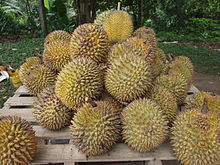
Back Drien ACE دوريان ARZ Tarutung BBC Durian Catalan Durian Danish Durian German Ντούριαν Greek Durian Spanish Durian Estonian خارگیل Persian
| Durian | |
|---|---|

| |
| Durians at a market | |

| |
| Cut durian revealing its pulp | |
| Scientific classification | |
| Kingdom: | Plantae |
| Clade: | Tracheophytes |
| Clade: | Angiosperms |
| Clade: | Eudicots |
| Clade: | Rosids |
| Order: | Malvales |
| Family: | Malvaceae |
| Subfamily: | Helicteroideae |
| Tribe: | Durioneae |
| Genus: | Durio L. |
| Type species | |
| Durio zibethinus[1] L.
| |
| Species | |
|
There are currently 30 recognised species (see the List of Durio species) | |
The durian (/ˈdʊəriən/, /ˈdjʊəriən/)[2] is the edible fruit of several tree species belonging to the genus Durio. There are 30 recognized Durio species, at least nine of which produce edible fruit.[3][4] Durio zibethinus, native to Borneo and Sumatra, is the only species available on the international market. It has over 300 named varieties in Thailand and 100 in Malaysia as of 1987.[3] Other species are sold in their local regions.[3]
Named in some regions as the "king of fruits",[4][5] the durian is distinctive for its large size, strong odour, and thorn-covered rind. The fruit can grow as large as 30 cm (12 in) long and 15 cm (5.9 in) in diameter, and it typically weighs 1 to 3 kg (2.2 to 6.6 lb). Its shape ranges from oblong to round, the colour of its husk from green to brown, and its flesh from pale yellow to red, depending on the species.
Some people regard the durian as having a pleasantly sweet fragrance, whereas others find the aroma overpowering and unpleasant. The smell evokes reactions ranging from deep appreciation to intense disgust. The persistence of its odour, which may linger for several days, has led some hotels and public transportation services in Southeast Asia to ban the fruit. The flesh can be consumed at various stages of ripeness, and it is used to flavour a wide variety of savoury and sweet desserts in Southeast Asian cuisines. The seeds can also be eaten when cooked.
- ^ "Durio L." Germplasm Resources Information Network. United States Department of Agriculture. 12 March 2007. Archived from the original on 30 May 2010. Retrieved 16 February 2010.
- ^ "durian". Lexico UK English Dictionary. Oxford University Press. Archived from the original on 27 April 2021.
- ^ a b c Morton, JF (1987). "Durian". Fruits of Warm Climates. Florida Flair Books; republished in New Crop Resource Online Program, Center for New Crops and Plant Products, Department of Horticulture and Landscape Architecture, Purdue University. ISBN 978-0-9610184-1-2. Archived from the original on 15 February 2021. Retrieved 5 February 2004.
- ^ a b "Hail the king of fruit – 10 types of durians from Malaysia". The Straits Times. 22 June 2015. Archived from the original on 27 May 2019. Retrieved 26 May 2019.
- ^ Cite error: The named reference
Heatonwas invoked but never defined (see the help page).
© MMXXIII Rich X Search. We shall prevail. All rights reserved. Rich X Search